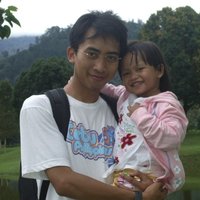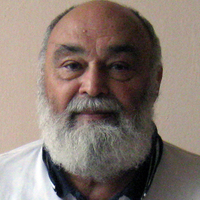Papers by robert haralick
Lecture Notes in Computer Science, 1998
arXiv (Cornell University), May 29, 2017
Proceedings of SPIE, Oct 30, 1975
One frequently used image compression method is based on transform coding. In terms of RMS error,... more One frequently used image compression method is based on transform coding. In terms of RMS error, the best transform is the Karhunen-Loeve (Principal Components). This method is not generally used due to computational complexity. In this paper we show that under isotropicity conditions the Karhunen-Loeve is almost separable and that an approximate fast principal components transform exists. Our results indicate that the fast K-L is nearly as good as the true K-L and that it yields better results than other discrete transforms such as DLB, SLANT, or Hadamard. The approximations and errors are discussed in terms of the RMS and RMS correlated error.
International Journal of Imaging Systems and Technology, 1996

Proceedings of SPIE, Mar 30, 1995
ABSTRACT In this paper, we describe a system that detects lines of various types, e.g. solid line... more ABSTRACT In this paper, we describe a system that detects lines of various types, e.g. solid lines and dotted lines, on document images. The main techniques are based on the recursive morphological transforms, namely the recursive opening and closing transforms. The advantages of the transforms are that they can perform binary opening and closing with any sized structuring element simultaneously in constant time per pixel, and that they offer a solution to morphological image analysis problems where the sizes of the structuring elements have to be determined after the examination of the image itself. The system is evaluated on about 1,200 totally ground-truthed IRS tax form images of different qualities. The line detection output are compared with a set of hand-drawn groundtruth lines. The statistics like the number and rate of correct detection, miss detection and false alarm are calculated. The performance of 32 algorithms for solid line detection are compared to find the best one. The optima...
Proceedings of SPIE, Mar 21, 1989
Abstract Application of the affine-invariant point-matching scheme proposed by R. Hummel and H. W... more Abstract Application of the affine-invariant point-matching scheme proposed by R. Hummel and H. Wolfson (1988) to the problem of recognizing and determining the pose of sheet metal parts is discussed. Attention is given to errors that can occur with this method due to quantization, stability, symmetry, and noise problems. These errors make the original affine-invariant matching technique unsuitable for use on the factory floor. An explicit noise model, which the Hummel and Wolfson technique lacks, is used. An optimal approach which ...

Proceedings of SPIE, Mar 7, 1996
In this paper, we describe a feature based supervised zone classifier using only the knowledge of... more In this paper, we describe a feature based supervised zone classifier using only the knowledge of the widths and the heights of the connected-components within a given zone. The distribution of the widths and the heights of the connected-components is encoded into a n multiplied by m dimensional vector in the decision making. Thus, the computational complexity is in the order of the number of connected-components within the given zone. A binary decision tree is used to assign a zone class on the basis of its feature vector. The training and testing data sets for the algorithm are drawn from the scientific document pages in the UW-I database. The classifier is able to classify each given scientific and technical document zone into one of the eight labels: text of font size 8-12, text of font size 13-18, text of font size 19-36, display math, table, halftone, line drawing, and ruling, in real time. The classifier is able to discriminate text from non-text with an accuracy greater than 97%.
A robust technique is described for solving the 3D-to-2D perspective projection pose estimation p... more A robust technique is described for solving the 3D-to-2D perspective projection pose estimation problem, given corresponding point sets. The technique has a considerable advantage over the least-squares (LS) technique in that with as many as 30% of the corresponding point pair matches completely incorrect the robust technique can determine the correct pose almost as accurately as the LS technique would if the LS technique were given only the correctly matched point pairs. The results of several hundred thousand experiments are reported that support the above conclusion
AGU Fall Meeting Abstracts, Dec 1, 2013
Page 1. Regression and Rejection of Automated Left Ventricle Boundary Delineation L Sui, RM Haral... more Page 1. Regression and Rejection of Automated Left Ventricle Boundary Delineation L Sui, RM Haralick, FH Sheehan, M Shimizu* ... [3] Clayton P. D., Harris L. D., Rumel S. R., Warner H. R., Left Ventricular Videometry, Computers and Biomedical Research, 1974; 7:369-79. ...

In image processing literature, thus far researchers have assumed the perturbation in the data to... more In image processing literature, thus far researchers have assumed the perturbation in the data to be white (or uncorrelated) having a covariance matrix σ2I, i.e., assumption of equal variance for all the data samples and that no correlation exists between the data samples. However, there has been very little attempt to estimate noise characteristics under the assumption that there is correlation between data samples. We develop a new and novel approach for the estimation of the unknown colored noise covariance matrix. We use the facet model to describe the noise free image, because of its simple, yet elegant mathematical formulation. Original contributions of this dissertation include: (1) Development of a new and novel approach for the simultaneous estimation of the unknown colored (or correlated) noise covariance matrix and the hyperparameters of the covariance model using the facet model . We also estimate, simultaneously, coefficients of the facet model. (2) Introduction of the Generalized Inverted Wishart ( GJW ) distribution to the image processing and computer vision community. (3) Formulation of the problem solution in a Bayesian framework using an improper uniform prior distribution for the facet model coefficients (i.e. a flat prior) and a Generalized Inverted Wishart ( GJW ) prior distribution for the unknown noise covariance matrix that is to be estimated. (4) Placing a structure on the hypercovariance matrix of GJW distribution, such that its elements are a function of the coefficients of a correlation filter. These filter coefficients in addition to the number of degrees of freedom parameter of the GJW distribution are called the hyperparameters. (5) Hyperparameters have constraints placed on them so that the resulting hypercovariance matrix remains positive definite. Therefore, we designed a new extension of the expectation maximization algorithm called the generalized constrained expectation maximization (GCEM) algorithm for the estimation of the hyperparameters using the sequential unconstrained minimization technique (SUMT) via barrier functions to incorporate the constraints. (6) Development of a new ridge operator called the integrated second directional derivative ridge operator (ISDDRO) based on the facet model. Our main focus here is the optimal estimation of ridge orientation. The orientation bias and orientation standard deviation are the measures of performance. The latter measures the noise sensitivity. (7) Comparison of ISDDRO using the noise covariance matrix estimation (ISDDRO-CN) with the same ridge operator under white noise assumption (ISDDRO-WN) and also with the most competing ridge operator multilocal level set extrinsic curvature (MLSEC) [5]. ISDDRO-CN has superior noise sensitivity characteristics compared to both ISDDRO-WN and MLSEC.
Oxford University Press eBooks, Dec 1, 1994

IEEE Transactions on Systems, Man, and Cybernetics, Jul 1, 1971
In many remote sensing applications millions of measurements can be made from a satellite at one ... more In many remote sensing applications millions of measurements can be made from a satellite at one time, and many times the data is of marginal value. In these situations clustering techniques might save much data transmission without loss of information since cluster codes may be transmitted instead of multidimensional data points. Data points within a cluster are highly similar so that interpretation of the cluster code can be meaningfully made on the basis of knowing what sort of data point is typical of those in the cluster. We introduce an iterative clustering technique; the procedure suboptimally minimizes the probability of differences between the binary reconstructions from the cluster codes and the original binary data. The iterative clustering technique was programmed for the GE 635 KANDIDATS (Kansas Digital Image Data System) and tested on two data sets. The first was a multi-image set. Twelve images of the northern part of Yellowstone Park were taken by the Michigan scanner system, and the images were reduced and run with the program. Thirty-thousand data points, each consisting of a binary vector of 25 components, were clustered into four clusters. The percentage difference between the components of the reconstructed binary data and the original binary data was 20 percent. The second data set consisted of measurements of the frequency content of the signals from lightning discharges. One hundred and thirty-four data measurements, each consisting of a binary vector of 32 components, were clustered into four clusters.











Uploads
Papers by robert haralick